By Doug Larson
Some readers will remember seeing first-run episodes of such westerns on television as The Rifleman and Gunsmoke. A common firearm seen in most of them is the lever action gun. And back in the days depicted in these television shows and in western movies, the lever action was used for hunting, shooting fun, contests, and self-defense. It was versatile and effective, and it still is.
Like the modern rifles of today – the AR-15 being the most common example – the lever gun was chambered for a variety of cartridges. And even though technology has advanced and semi-automatic rifles and carbines are common, the lever gun is still a viable platform. And it is great fun to shoot.
It may not have the magazine capacity of an AR-15 and it is not self-loading nor can it be fired quite as fast, but with the proper techniques and practice, it is very fast to shoot, accurate, and has enough magazine capacity to hold its own in most life-or-death encounters. Although there are exceptions, most such incidents are at close range where iron sights are adequate and the number of rounds fired is few.
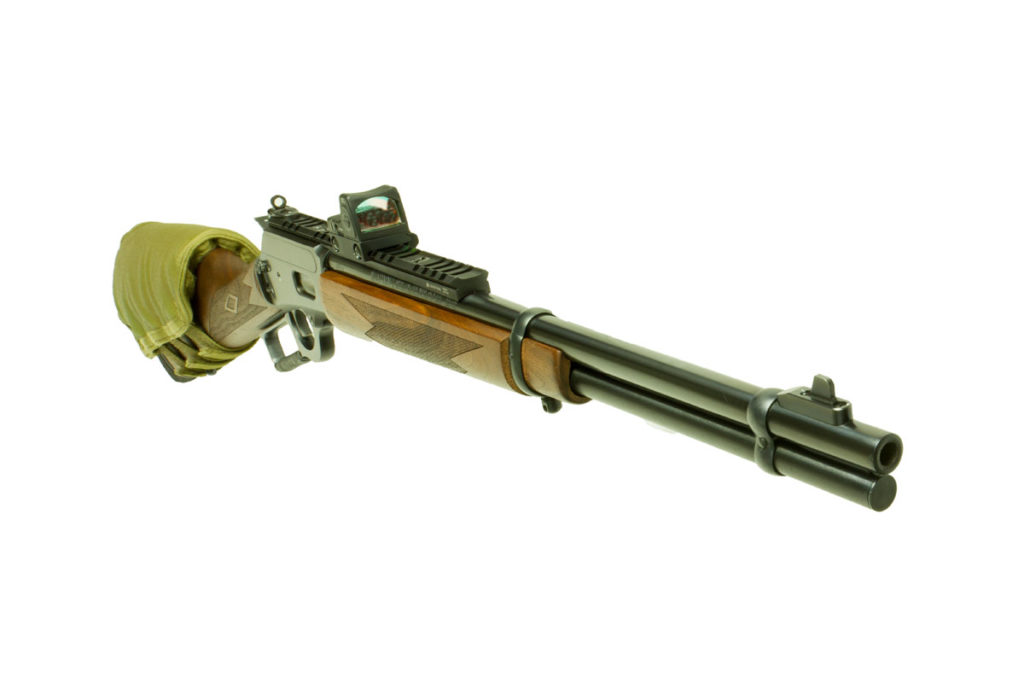
The design of this Marlin 1894c is faithful to the original design, but with some modern updates. To make it even more useful for personal defense in the 21st century, improvements include a Lever Rail, ghost ring rear and post front sight from XS Sights along with a Trijicon RMR red dot sight. The padded cheek rest has been added to raise the shooter’s eye to the level of the RMR. (Doug Larson photo)
The versatility of lever guns became obvious when a group of gun writers and experienced shooters recently met at Gunsite Academy located near Prescott, Arizona for a three-day class using lever action rifles and carbines. Taught by experienced Gunsite instructors and range masters, Lew Gosnell, Ed Head and Gary Smith, the basics as well as the finer points of gun handling and marksmanship with the lever gun were presented and practiced until all students gained a satisfactory level of competence.
So, why would anyone consider using a lever gun instead of an AR-15 for any task these days? Well, unfortunately, some readers live in jurisdictions where the possession or use of the modern rifle – the AR-15 – is infringed. But in some of those same jurisdictions, possession, and use of a lever action gun is not. After all, it’s just a “cowboy” gun and does not bring to mind the irrational fear that some people feel at the mere sight of an AR-15. In times of civil unrest, it can be very effective for use as a defensive tool, and in fact, I know of at least one law enforcement officer, when he found himself in just such an environment, armed himself with a lever gun for that very reason.
But proper training and then practice are – as they are with all firearm self-defense skills – required for the lever gun to be effective. A major problem though is finding the right training. Despite the increase in defensive firearms training instructors and schools, only a very few have expertise with lever guns. A quick Internet search revealed that of the few that offer lever action courses, only one appears to offer classes that are more than a few hours long. That’s Gunsite Academy, the oldest and the most prestigious privately owned firearms training center in the world.
CURRICULUM
First and foremost, do not kid yourself. You cannot learn how to properly run a gun and fight effectively with it from watching a video, reading a book or reading this article. There is no substitute for quality instruction and then practicing techniques the right way while an experienced instructor watches and immediately corrects any errors. And the first step in learning is to realize you probably don’t know that there are things you don’t know. To give you a flavor of the instruction available, here are some of the things taught at Gunsite.

To gain competence, accuracy and speed, Gunsite classes practice shooting on the square range at various distances while instructors observe, coach and correct. (Doug Larson photo)
Safety is the most important consideration and is constantly emphasized. The four rules of gun safety are introduced at the beginning of class after which the instructors get immediately into the meat of the course, starting with carry techniques. A sling on a long gun is like a holster for a handgun. It gives the shooter a way to safely carry the gun hands-free. But getting a rifle or carbine into use from sling carry can be slow and dangerous if not done correctly.
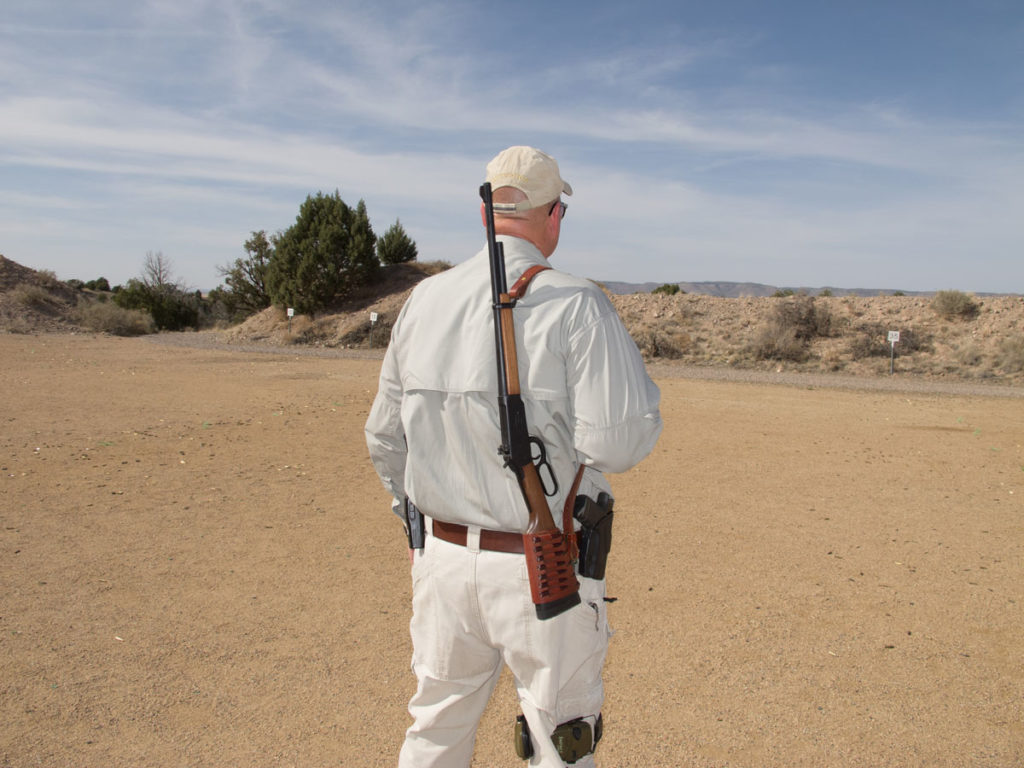
Gunsite instructor and range master Lew Gosnell demonstrates the American method of carrying a rifle on a sling. (Doug Larson photo)
There is more than one way to carry a gun on a sling, so American and African carry were demonstrated. Then the proper way to put the gun quickly into action from both carry methods was taught and practiced. Galcomakes a fine sling called the Riflemann Sling which I used during the class. Another good sling maker is Andy’s Leather.
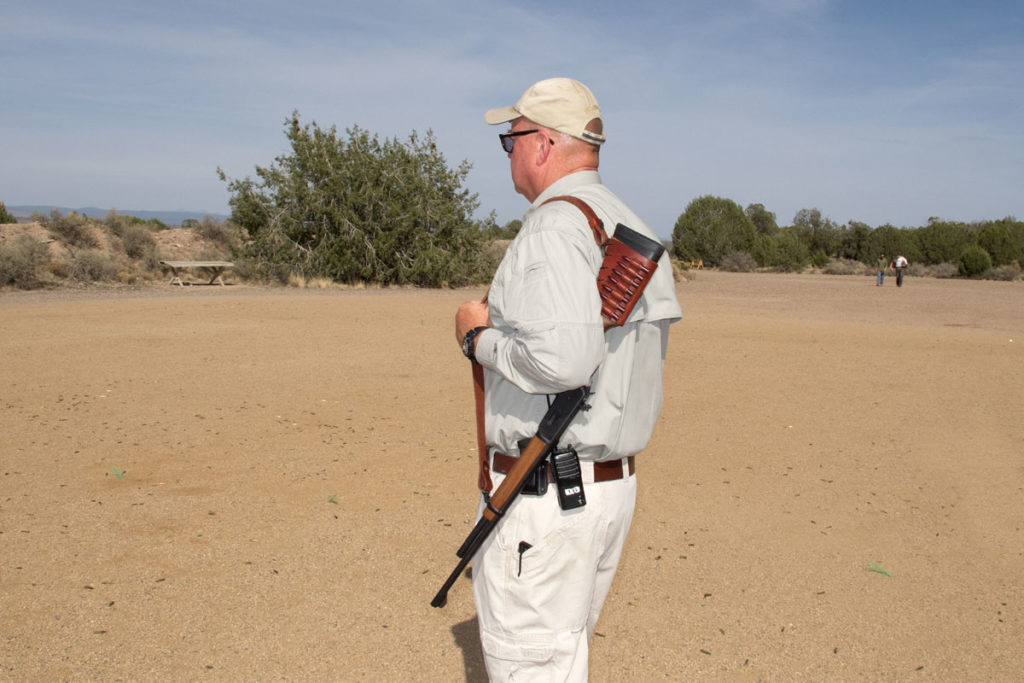
This is what African carry with a sling looks like as demonstrated by Gunsite instructor and range master Lew Gosnell. (Doug Larson photo)
Sometimes the lever gun may be carried in the hands in a low ready or high ready position. Controlling where the muzzle is pointed and then shouldering the gun and getting off a shot safely and quickly requires proper technique. Students practice these skills slowly at first, then faster so speed and accuracy improve.

The lever gun at the low ready. This is a field position used for scanning and assessing threats, shown here by Gunsite instructor and range master Lew Gosnell. (Doug Larson photo)
Having the ability to shoot the lever action gun from different shooting positions is important. These include standing, speed kneeling, braced kneeling, sitting and prone. During the course, I used Alta Industries elbow and knee pads for protection when kneeling or shooting prone and was glad I had them.
When carrying the lever gun, it is common to have a round chambered and the action on safe or the hammer at half cock. While some lever guns like the modern Marlins have a safety button on the receiver below the hammer that is pushed from right to left to disengage, others have no safety button but rely on a safety or half cock hammer position. With either setup, when carrying the gun in the hands, the thumb of the trigger hand should always be positioned on the hammer so that when the gun is brought up to aim, the hammer can be quickly cocked. For Marlins that have the safety, it can be pushed off at the same time. When lowering the gun and the threat is gone, the safety – if there is one – and the hammer should be moved to the safe position. All of this must be done often in practice so that the actions become automatic.
A feature of some lever guns is the tubular magazine that is located beneath the barrel. Other lever guns have a box magazine below the receiver. For guns with a tubular magazine, there may be a loading port located forward on the tube which is opened by pulling an inner magazine tube forward so that cartridges can be dropped in. Some tubular magazine lever guns have a loading gate on the side of the receiver which makes keeping the magazine full easier and loading faster.
With side loaders, if you shoot one round, load one round. If you shoot two rounds, load two rounds. That keeps the magazine full, ready for any threat. When topping off the magazine, keep the gun shouldered and eyes scanning for danger. But if the magazine is empty and there is no time to refill it, the lever gun is not out of the fight. With the action open, a round can be dropped into the receiver – either through the ejection port in the case of a Marlin or through the top of the action for a Winchester – the action closed and the round fired.
Regardless of the lever gun design, having spare rounds where they are easily and quickly available to load and shoot is a must. And dropping the rounds in a pocket will work, but it is not the best way to carry spares. A much better way is with a belt or belt slide with cartridge loops which keeps the ammunition oriented for fast and easy retrieval. I used belt slides made by Simply Rugged Holsters (www.simplyrugged.com) and which proved to be of excellent quality.
An alternative to loops on the belt is a similar device with cartridge loops that are made of cloth or leather and that attaches to the buttstock. An example is the Ammo Caddy from Versacarry.
Follow up shots can be delivered very rapidly with a lever gun. It just seems natural to cycle the lever after firing a round, and because the trigger, or control hand, does not have to be removed from the lever loop, time is saved. Be sure though that the lever is cycled with force completely in both directions because short stroking it can cause malfunctions. As soon as the shot is fired, the lever should be worked without removing the gun from the shoulder or lifting the head off the stock. These skills – loading, cycling the action, shouldering the gun from a slung position or a hand carry position and shooting – should be practiced slowly at first, adding speed as the shooter gets used to the activity. It takes hundreds of repetitions before gun handling becomes automatic.
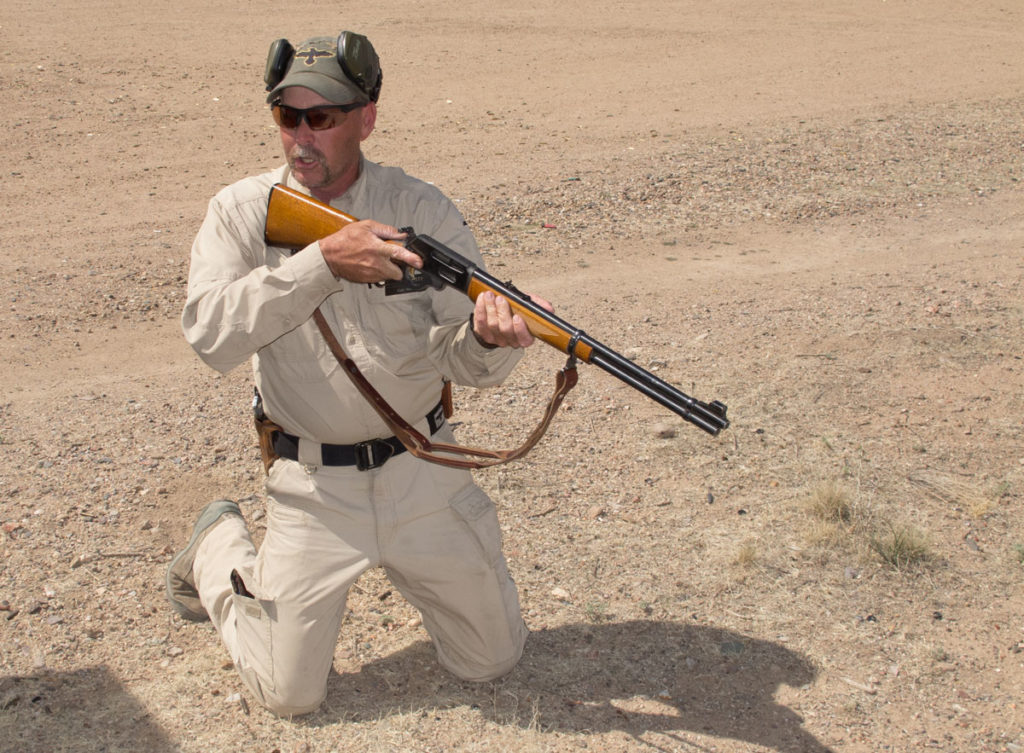
The double kneeling position demonstrated here by Gunsite instructor and range master Gary Smith is a very versatile position for use behind cover or concealment. (Doug Larson photo)
GUNS AND EQUIPMENT
Lever guns are made to chamber many different calibers from .22 up to cartridges capable of stopping any animal likely to be encountered on the North American continent. Whether you need protection against grizzly bears or criminals, there is a lever gun that will work. Some of the most popular chamberings are .30-30 Winchester and the pistol calibers – like .45 Colt, .44 Magnum, and .357 Magnum. Then there are lever guns chambered for old favorites like the .45-70 Government and high power rifle cartridges. And if you want something a little different, Big Horn Armory builds some very high-quality lever guns in .500 S&W Magnum.
Many people who shoot lever guns prefer one chambered in a pistol caliber. Recoil is modest compared to high power rifle calibers, but ammunition is less expensive and a pistol can be carried that is chambered for the same cartridge. This is one of the reasons that pistol caliber lever guns were so popular in the early days. Although a pistol caliber lever gun can be a good choice for self-defense and it increases the range of the pistol cartridge, it does not have the range of a rifle caliber gun. Hornady has helped to narrow the gap though.
Several years ago, Hornady introduced its LeverEvolution line of ammunition designed to increase the range and usefulness of ammunition used in lever guns. With a soft pointed polymer tip that will not detonate the primer of a cartridge in front of it, it can be used in a tubular magazine. And the ballistic coefficient is improved. This and modern powders increase velocity and the useful range of pistol caliber lever guns.

Speed kneeling is demonstrated by Gunsite instructor and range master Gary Smith. The position is very fast to assume and recover from. (Doug Larson photo)
For part of the Gunsite class, I used .357 Magnum Hornady LeverEvolution ammunition which more than doubled the effective range to nearly 200 yards. For short range practice, I used Doubletap .38 Special ammunition which is more economical and produced less recoil. But a special magazine follower from Beartooth Mercantile had to be installed to work with the pointed LeverEvolution ammo. To spot hits on targets during training, a good set of binoculars helps and I used a MeoStar B1 10×32 set from Meopta.
Not long ago, Mossberg introduced a lever gun with a futuristic appearance and features that permit some modern accessories to be mounted on the gun. The Mossberg 464 SPX Lever Action rifle’s appearance will assault the eye of traditionalists but brings the lever gun into the modern world. It has a tactical appearing buttstock that is adjustable for length of pull and comb height, as well as a forend that is equipped with Picatinny rails allowing the attachment of a light or laser.
But even the very traditional Marlin lever action rifle can be updated despite its loyalty to the original design from the late 1800s. XS Sights makes a Picatinny rail called the Lever Rail that can be installed permitting the use of a scope or red dot sight like the Trijicon RMR that I used during the class. The Lever Rail also has a ghost ring rear sight and white line front blade that replaces the buckhorn rear and hooded ramp front sight that comes stock on the Marlin. These changes greatly improve the speed of target acquisition.
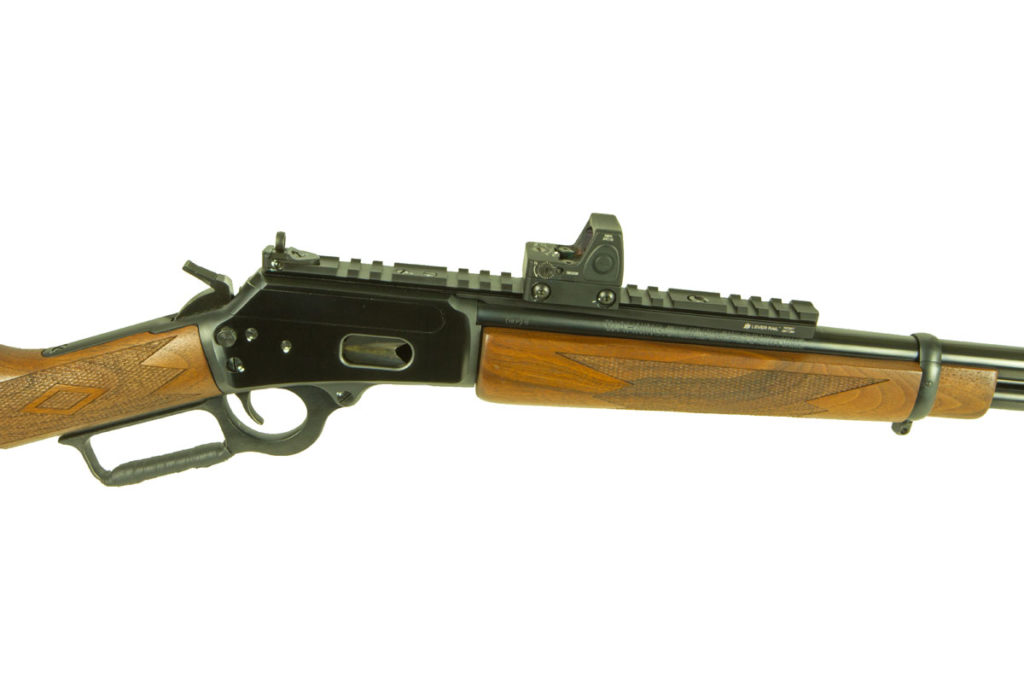
The XS Sights Lever Rail is easily installed on this Marlin 1894 chambered in .357 Magnum. No alteration of the gun is required and the rail permits the use of a variety of modern optics. (Doug Larson photo)
And for those savvy shooters who appreciate the benefits of ghost ring sights, Skinner Sights makes an excellent ghost ring, or peep, sight for a variety of lever guns.

XS Sights makes a front post with white line that greatly increases the speed of sight acquisition. (Doug Larson photo)
Don’t dismiss lever action rifles and carbines for self-defense. They are not outdated relics of the old west. These guns, even without modern accessories or design changes, but with the right training, can be a great alternative for personal protection.
***Shop GunsAmerica for your next lever action rifle***
A former Contributing and Field Editor for Guns & Ammo magazine, Doug Larson’s articles have appeared in many top firearm publications. He has completed hundreds of hours of firearm and self-defense training provided by some of the finest world class gun fighting instructors and schools. He has experience with handguns, rifles, shotguns, submachine guns, machine guns and other crew served weapons.
